Many laud the influence of rock type on wine and whisky, but Alex Maltman highlights the unsung connections between geology and beer
Maltman, A., Wine, whisky and beer—and geology?
Geoscientist 29 (6), 10-15, 2019
https://doi.org/10.1144/geosci2019-033;
Download the pdf here
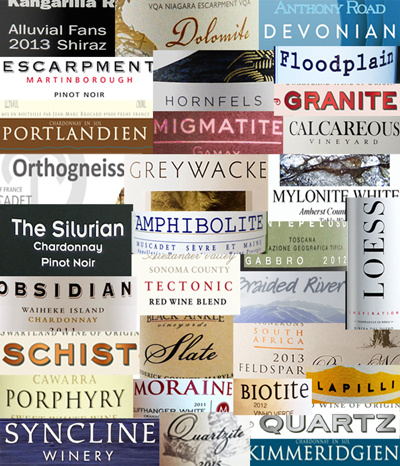
You might be puzzling about what geology has to do with these alcoholic beverages. And certainly, if you’re a beer drinker it’s unlikely that you will have come across much mention of geology affecting your drink, though whisky lovers may have read of an influence of bedrock on the distilleries’ water supply. On the other hand, wine enthusiasts will be well aware of the importance that some attach to vineyard geology, even to the extent of claiming that individual rocks and minerals can be tasted in wine. However, the scientific evidence on all this gives a much more complex picture. In this article, I will suggest that while vineyard geology can affect how well grape vines perform, its effect on wine is over-hyped and its role in whisky is nuanced, at best. With beer, in contrast, geology has a clear relevance, certainly in brewing history, but one that is usually overlooked.
Wine and geology
Vineyard geology has long been held as important, with many a wine being named after something geological. But today such ideas have reached unprecedented heights. There are consortia of producers in highly diverse places claiming a commonality of their wines simply because their vineyards have the same bedrock. There are books urging drinkers to select wines by rock type; there are restaurants with wine lists organised by geology: alluvial wines, volcanic wines, granite wines, limestone wines and so on. Yet none of these claims indicate what the geology actually does or how a particular rock brings something special to the wine in your glass, and our present scientific understanding makes it difficult to see how this might happen.
Geology determines the vineyard landscape (Fig. 1) and soil properties, and hence indirectly affects vine growth. But its main influence concerns water availability to the plant roots. All vines need good drainage, though this can be provided by various soils, for example, the gravels in Bordeaux, chalk in Champagne and the slate scree in Germany’s Moselle valley. But vine roots also need access to moisture during dry periods, perhaps through the presence of clay. In practice, however, the physical factors affecting vine growth are commonly manipulated: soils are modified and highly sophisticated irrigation technologies provide a precise water supply to a vine, effectively over-riding the natural geology.
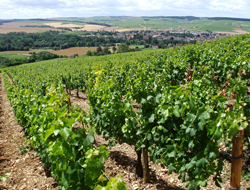 Fig 1, Chablis, northern France, looking southwest. The finest vineyards are in the foreground, on the best-drained parts of moderately inclined slopes, which face southwest, thus maximising exposure to the warmest sunshine. Vineyards in the background produce lesser wines; the most ordinary wines come from the exposed and windy highest parts of the foreground slope, behind the viewpoint.
Fig 1, Chablis, northern France, looking southwest. The finest vineyards are in the foreground, on the best-drained parts of moderately inclined slopes, which face southwest, thus maximising exposure to the warmest sunshine. Vineyards in the background produce lesser wines; the most ordinary wines come from the exposed and windy highest parts of the foreground slope, behind the viewpoint.
Much of the journalistic and advertising wine prose that enthuses about geology implies that (unspecified) matter is taken up by the vine roots and then conveyed through the vine to the eventual wine. However, there is a whole series of disconnects between the geochemistry of the vineyard ground and what ends up in your wine glass. For example, the vine attempts to select and balance its uptake of the fourteen or so mineral nutrients it requires, irrespective of the bedrock, and any imbalances are routinely checked for by a conscientious grower and corrected as necessary. In any case, in practice year-on-year most of the nutrients come not from the geology, but from the organic humus in the soil (or artificial fertilizer). The ratios of the nutrients change substantially during vinification, such that their proportions in a finished wine bear only an indirect and distant relationship with the geologic minerals in the vineyard. Moreover, their concentrations in wine are tiny (a typical wine has only around 0.2% of inorganic matter in total, mostly potassium) and, apart from salt, they lack taste anyway. Certainly, their presence can indirectly affect a range of chemical reactions and to influence our taste perceptions, but these are complex and circuitous effects, a long way from vineyard geology being a dominant factor in wine.
An apparent importance for vineyard geology is fostered by our calling on geological words to communicate taste perceptions. For example, a number of “geological smells” arise from the highly aromatic compounds that settle from the air onto exposed ground surfaces: an earthy smell results from a terpene known as geosmin and the aroma of wet stone is due to the release of various organic oils collectively termed petrichor. Some wines are described as being flinty, presumably through a recollection of the distinctive smell produced by striking lumps of flint together (which involves volatilizing sulphur impurities at the flint surface). Thus, terms like these are being used as mental associations, metaphors: vineyard geology cannot—in any direct, literal way—be tasted in wine.
Whisky and geology
Marketing of Scotch whisky often lauds the virtues of soft water and frequently mentions granite, a rock commonly associated in the public eye with the Scottish Highlands. Certainly, an image of crystal waters tumbling down granite mountains makes good advertising copy. In reality, however, few distilleries use water that has been in contact with granite. Fettercairn, Aberlour, Arran and Glenfiddich are exceptions; some, Oban for instance, capitalize on the consistency offered by mains water. In any case, the majority of distilleries in Scotland draw their waters from rivers and lochs, and this surface water will have had little opportunity to interact with bedrock. And during distillation, the water is, of course, lost. (Almost invariably, reduction of the alcoholic strength before bottling utilises de-ionised water and mostly takes place in centralised plants.)
Over half of Scotland’s distilleries produce “Speyside” whiskies, and their waters indeed tend to be soft, but mainly through contact with Dalradian schists and quartzites, rather than granite. However, the claim that this softness is the key to the character of Speyside whiskies is contradicted by those distilleries that use fairly hard water, through having had some contact with Dalradian calc-schists and meta-limestones (Fig 2). Examples are Glen Moray, Dailuaine and Cragganmore. Some Speyside distilleries use groundwater, either from springs (Glenlivet) or from wells (Auchcroisk, Macallan), and this can be distinctly hard.
 Fig. 2, Strathisla distillery, the oldest continuously operating distillery in Scotland, trumpets its use of hard water, which originates in Dalradian limestones around the town of Keith. (Image: CC0 Public Domain)
Fig. 2, Strathisla distillery, the oldest continuously operating distillery in Scotland, trumpets its use of hard water, which originates in Dalradian limestones around the town of Keith. (Image: CC0 Public Domain)
The claim is also contradicted by those distilleries at that other pre-eminent area of quality whisky production, the Isle of Islay, being located on the same kinds of Dalradian meta-sedimentary rocks (Fig. 3), which yield the same ranges of soft and hard water. For example, the celebrated Islay distilleries of Laphroaig, Lagavulin and Ardbeg use soft, surface water that flowed over Dalradian quartzites, whereas Bunnahabhain uses hard water piped directly from springs in Dalradian dolomite. Others of the island’s whiskies are regarded as “Islay” in style, but use quite different waters. Bowmore distillery takes its water from the Laggan River, which passes over limestone, dolomite and grey sandstone; Kilchoman and Bruichladdich water traverses Late Proterozoic sandstones.
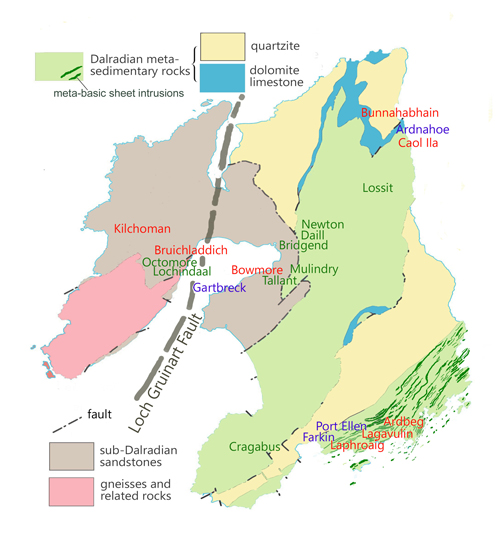 Fig. 3, Islay whiskies are often said to have a commonality of style, but the negligible influence of geology in this is apparent from the variety of rocks shown even on this highly simplified geological map of the island. Also shown are representative distilleries, both old (in green), operating (in red) and planned (in blue). Sharp ridges of tough meta-basic sheets have produced a multitude of hidden glens ideal for illicit distilling and a maze of offshore reefs and islets that conceded safe navigation only to those with local knowledge. (Map adapted from: Maltman, A. The Geology of Wine, Spirits and Beer. Encycl. Geol. 2020 © Elsevier).
Fig. 3, Islay whiskies are often said to have a commonality of style, but the negligible influence of geology in this is apparent from the variety of rocks shown even on this highly simplified geological map of the island. Also shown are representative distilleries, both old (in green), operating (in red) and planned (in blue). Sharp ridges of tough meta-basic sheets have produced a multitude of hidden glens ideal for illicit distilling and a maze of offshore reefs and islets that conceded safe navigation only to those with local knowledge. (Map adapted from: Maltman, A. The Geology of Wine, Spirits and Beer. Encycl. Geol. 2020 © Elsevier).
The range of Campbelltown whiskies come from just three distilleries (Glengyle, Glen Scotia and Springbank) and all three have the same water source, a small loch located on similar Dalradian meta-sedimentary rocks to Speyside and Islay. Some “Highland” whiskies (e.g. Tullibardine, Aberfeldy and Blair Atholl) also involve waters flowing over Dalradian meta-sedimentary bedrock, though most coastal examples utilise rather hard waters. Examples include Clynelish and Brora, both associated with the Jurassic Brora coalfield, and Glenmorangie, Old Pulteney and Orkney’s Scapa and Highland Park—all on carbonate-rich Old Red Sandstone.
There are some general correlations between the inorganic content of the water used in distilling and the regional geology, but research has failed to find any links with the sensory qualities of whisky (Wilson,
PhD Thesis 2008). So as far as the consumer is concerned, it seems that any effect of geology on whisky taste is swamped by other factors, such as the nature and quality of the starting grain, the degree to which it is peated, the architecture of the stills and the distilling methodology, and the nature and duration of the cask ageing.
However, there are other, subtle influences of geology on the Scotch whisky industry. It is no coincidence that Islay, home of the most heavily peated whiskies, has exceptionally thick deposits of peat, accumulated in the extensive, low-lying tracts developed on unusually soft Dalradian schists adjacent to the regionally important Loch Gruinart fault zone (Fig. 3). Also, some long established distilleries have grown from their illicit predecessors, located where the geology gave hidden sites and crafty getaways (Fig. 3).
American whiskey has its heartland in Kentucky and Tennessee, and here, too, special distilling water is claimed, but for a reason opposite to soft water from granite: hardness due to limestone. But, as with Scotch, the extent to which the water itself affects flavour is moot. A whole range of tastes is produced from this hard water, and within the span are whiskeys made elsewhere in the country with distinctly soft water, for instance, Tuthillltown (New York) on Ordovician (Trenton) shale and Westland (Seattle) with Cedar River water from the Cascade volcanics. The water in Kentucky and Tennessee originates in Ordovician limestones, though the distilleries access it differently. For example, Knob Creek and Woodford Reserve (Fig. 4) use spring water, as does Jack Daniel’s for its Tennessee whiskey (its location is even called Cave Springs). Maker’s Mark draws its water from a spring-fed lake; Heaven Hill, Old Forester and Buffalo Trace use municipal water.
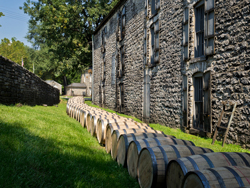 Fig. 4, Woodford Reserve Distillery, the oldest distillery in Kentucky. It is constructed of grey, Middle Ordovician Tyrone Limestone though the use of stone as a building material for distilleries is unusual. Although of no known effect on the plant’s whiskey, nearby is the 1.5 km wide Versailles impact crater. (Image: CC0 Public Domain)
Fig. 4, Woodford Reserve Distillery, the oldest distillery in Kentucky. It is constructed of grey, Middle Ordovician Tyrone Limestone though the use of stone as a building material for distilleries is unusual. Although of no known effect on the plant’s whiskey, nearby is the 1.5 km wide Versailles impact crater. (Image: CC0 Public Domain)
Other factors have contributed to the pre-eminence of Kentucky and Tennessee whiskey, and to some extent geology is among them. The Ordovician ocean in this area yielded more phosphorus than could be used by the flora and fauna of the time, and the excess was precipitated as apatite and phosphorite nodules, common in today’s bedrock. These now lead to soils unusually rich in phosphorus, favouring the growth of corn (maize) for distilling (and the famous “blue grass” of the region). It also helps account for the abundant indigenous white oaks here, essential for cask-ageing and the whiskey’s distinctive taste.
Beer and geology
Besides water, the primary constituents of beer are cereals and hops—and geology has some influence on both. For example, soils overlying Cretaceous Gault Clay give higher barley yields in dry years than those on Lower Greensand soils, because of their better water retention. Hops, as with grapevines, need free-draining soils with some access to water, such as those derived from Devonian and Triassic sandstones in Herefordshire and Worcestershire, the thick Tertiary molasses of the Hallertau region near Munich, and the volcanic alluvium of the Yakima and Willamette valleys, USA.
It is with water, though, that geology has direct relevance. Historically at least, breweries mainly used well water and, unlike with whisky, that water dominates the finished product. And water chemistry, pivotal to the brewing process (although these days brewers adjust things as appropriate), depends on the aquifer. As a general rule, anions have flavour effects whereas cations affect the brewing: efficient mashing (leaching fermentable sugars from the cereals) is crucial and usually needs a pH within the range of 5.2-5.8.
In the UK, centralised brewing arose at the time of the industrial revolution, and it soon became clear that certain towns consistently delivered a more desirable product. Examples included London, Edinburgh, Masham, Faversham and Carlisle, but no location was to become more famous than Burton-on-Trent. The groundwater at Burton is now universally acknowledged to be ideal for brewing pale ale, or English “bitter”. It offers (Fig. 5) an ideal pH and ionic balance, and levels of sulphate that give an unrivalled taste and bite (still known to aficionados as the “Burton snatch”, and also found in Dortmund beers). Moreover, all this allowed high hopping rates and hence sufficient stability for the beer to withstand being transported long distances, and even exported—hence “Export Ale”, and the journey to India, the birth of today’s almost ubiquitous India Pale Ale or IPA.
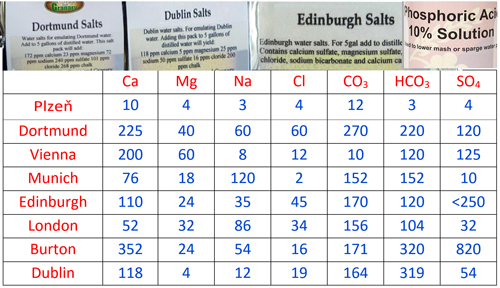 Fig. 5, Typical ionic composition of waters from major brewing centres. Compiled from various sources.
Fig. 5, Typical ionic composition of waters from major brewing centres. Compiled from various sources.
The key to all this, though little acknowledged in brewing literature, is geology: at Burton, the Sherwood sandstone aquifer is overlain by highly gypsiferous Mercia mudstone (Fig. 6). Similarly, suitable hydrogeological conditions exist at the other early brewery towns. Yorkshire’s Tadcaster, for example, has Upper Permian marl containing lenses of gypsum and anhydrite overlying the dolomitic Magnesian Limestone aquifer (Fig. 7), and a water yield enhanced by the several permeable faults.
 Fig. 6, Simplified cross-section of the Burton-on-Trent district, England. Breweries obtain water from both bedrock and surficial deposits, but both are gypsiferous and rich in calcium, magnesium, sulphate and other ions. Brewers elsewhere, including homebrewers, mimic the water by adding “Burton Water salts”. (Credit: Maltman, A. The Geology of Wine, Spirits and Beer. Encycl. Geol. 2020 © Elsevier).
Fig. 6, Simplified cross-section of the Burton-on-Trent district, England. Breweries obtain water from both bedrock and surficial deposits, but both are gypsiferous and rich in calcium, magnesium, sulphate and other ions. Brewers elsewhere, including homebrewers, mimic the water by adding “Burton Water salts”. (Credit: Maltman, A. The Geology of Wine, Spirits and Beer. Encycl. Geol. 2020 © Elsevier).
Simultaneously, on the Continent, new aromatic hops were being introduced, together with so-called “bottom fermenting” yeasts and cool storing of the finished product, a process known in German as “lagering”. And, just as in England, one town set the benchmark for this new, clean tasting lager beer—Plzeň in the Czech Republic. In German this town was known as Pilsen and its product, the Pilsener, is a name found today in various forms of spelling on beer labels around the world. This more delicate style of beer is best produced from soft, low mineral content water—just as at Plzeň, located partly on Stephanian (Upper Carboniferous) lacustrine, feldspathic sandstones and partly on Upper Proterozoic metamorphic rocks from which the water was drawn. The latter are intrinsically impermeable, but sufficiently fissured to give some storage capacity. The water at České Budějovice, 150 km to the southeast of Plzeň, is even softer and drawn from a 300-m-deep artesian well in fractured, older Proterozoic gneisses and migmatites. German speakers know the town as Budweis and its beer as the Budweiser: the original Budweiser beer is still produced there.
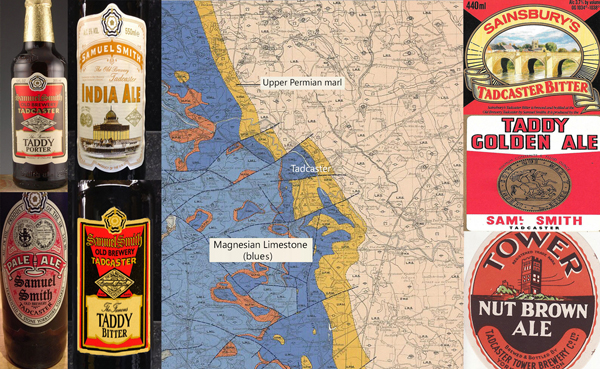 Fig. 7, The small town of Tadcaster, Yorkshire, made its name with beers using hard, sulphate-rich waters from the NE-dipping Magnesian Limestone (pale blue and dark blue on the map) and overlying gypsum-rich Permian marl. Some Tadcaster beers are affectionally called “Taddy”. (Contains British Geological Survey materials © NERC [2019]; Map adapted from Maltman, A. The Geology of Wine, Spirits and Beer. Encycl. Geol. 2020 © Elsevier).
Fig. 7, The small town of Tadcaster, Yorkshire, made its name with beers using hard, sulphate-rich waters from the NE-dipping Magnesian Limestone (pale blue and dark blue on the map) and overlying gypsum-rich Permian marl. Some Tadcaster beers are affectionally called “Taddy”. (Contains British Geological Survey materials © NERC [2019]; Map adapted from Maltman, A. The Geology of Wine, Spirits and Beer. Encycl. Geol. 2020 © Elsevier).
But what about those brewing centres with waters that lack the natural balance of the Burton and Plzeň waters? For example, Munich with all its nearby hop fields, chiefly draws its water from Pleistocene fluviatile and glacio-fluvial sands and gravels which, deriving from the nearby calcareous rocks of the Bavarian Alps, have a high carbonate content and high alkalinity that is unsuitable for pale beers. To the rescue, however, come roasted malts. These contain phosphates that are released on mashing as phosphoric acid, which decreases the pH into an acceptable range. It’s why Munich became best known for its dark beers. Even the paler lagers produced there today have a richer taste than, say, Pilsners, partly because of the unfermented compounds induced by the relatively hard water.
Vienna waters, although also derived from calcareous rocks in the Alps, are less hard and therefore require a lesser proportion of roasted malt. The result is the characteristic red-amber Viennese lager. Similarly, hard waters in London from the Cretaceous Chalk lead to copper-coloured ales there and, where greater degrees of malt roasting were needed, the historically famous dark ruby porters of the city.
But perhaps the extreme case of using heavily roasted malts is in Dublin, and most famously at the Guinness brewery. The building is sited on bedrock of Carboniferous Limestone and obtains its water from the Blessington reservoir, in the Wicklow Mountains to the west. Although the reservoir itself is located on Silurian meta-sedimentary and volcanic bedrocks, it is fed from limestone-derived gravels that make the water hard. Highly roasted malts lower the mash pH adequately, though the resulting liquor leads to a beer high in tannins, a grainy mouth-feel and the very dark colour characteristic of Dublin or Irish stout, of which Guinness is the most celebrated example. It is one of the world’s most distinctive drinks—and essentially because of geology.
So, it is easy to argue that geology has a whole range of influences on beer, both direct and indirect. In other words, of the drinks discussed in this article it is the importance of geology for whisky, and especially for wine, that is most trumpeted—but it is the unsung connection with beer that is the closest.
Alex Maltman is in the Department of Geography and Earth Sciences, Aberystwyth University, Aberystwyth, Wales SY23 3DB, UK.
Further reading
Bamforth, C.W. (2006) Scientific principles of malting and brewing. Eagan, Minnesota: American Association of Cereal Chemists, 256 pp.
Maltman, A.J. (2013) Minerality in wine: a geological perspective. Journal of Wine Research 24, 169–181.
Maltman, A. (2018) Vineyards, rocks, and soils: The wine lover’s guide to geology. New York: Oxford University Press, 256 pp.
Maltman, A. (2020) The Geology of Wine, Spirits and Beer, in the Encyclopedia of Geology (2nd edition), by Scott Elias & David Alderton (eds), Elsevier.
Meinert, L.D. (ed.) (2018) Terroir: science related to grape quality. Elements 14, 153-195.
Russell, I. & Stewart, G. (eds.) (2014) Whisky: Technology, Production and Marketing. Oxford, Academic Press, 384 pp.
Wilson, C.A. (2008) The Role of Water Composition on Malt Spirit Quality. PhD Thesis. Heriot-Watt University, Edinburgh. Available at
http://www.ros.hw.ac.uk/handle/10399/2261